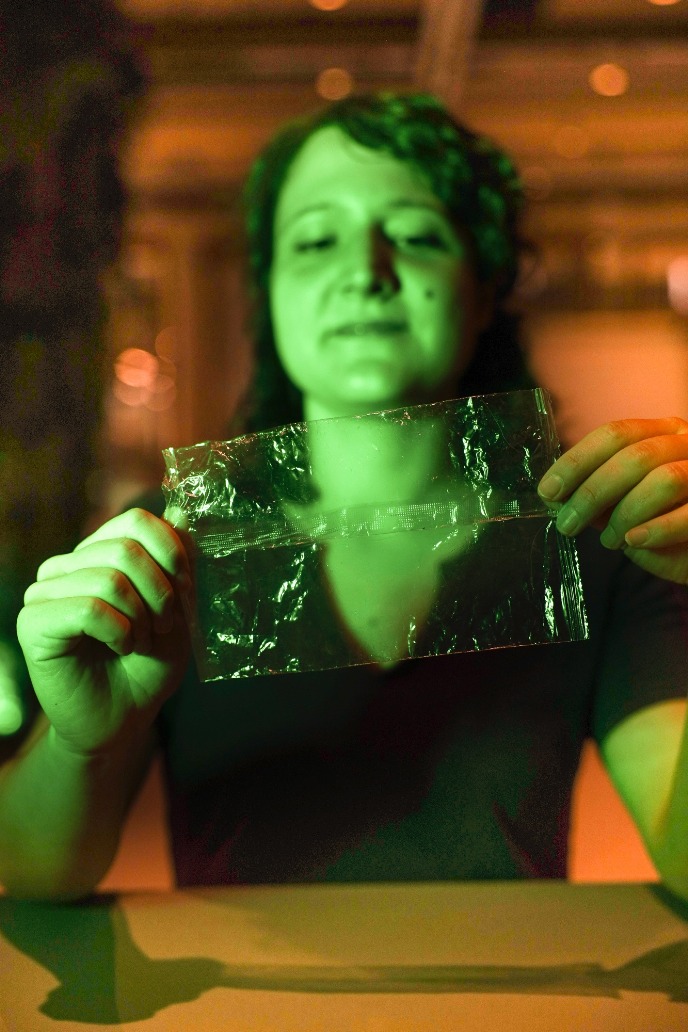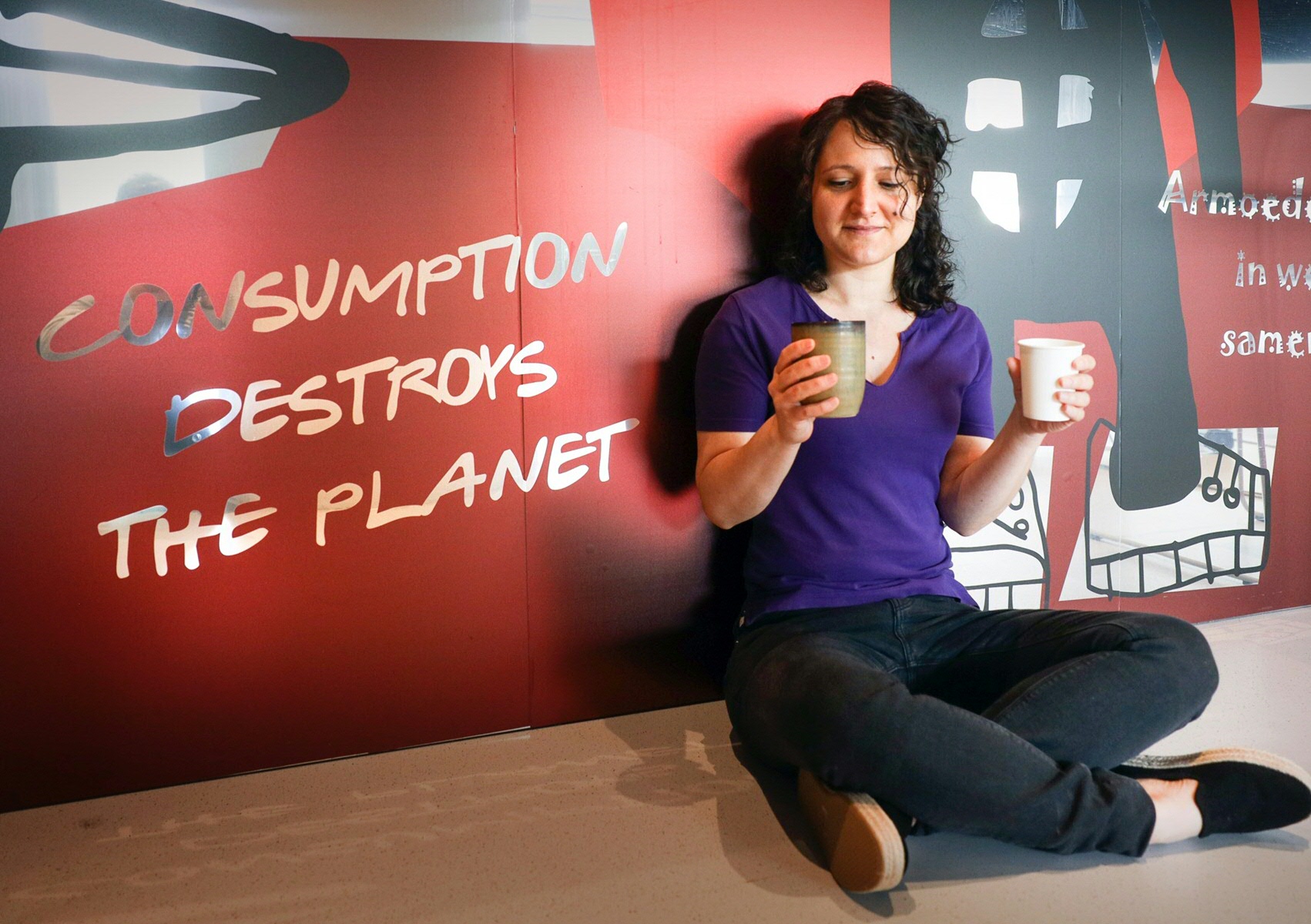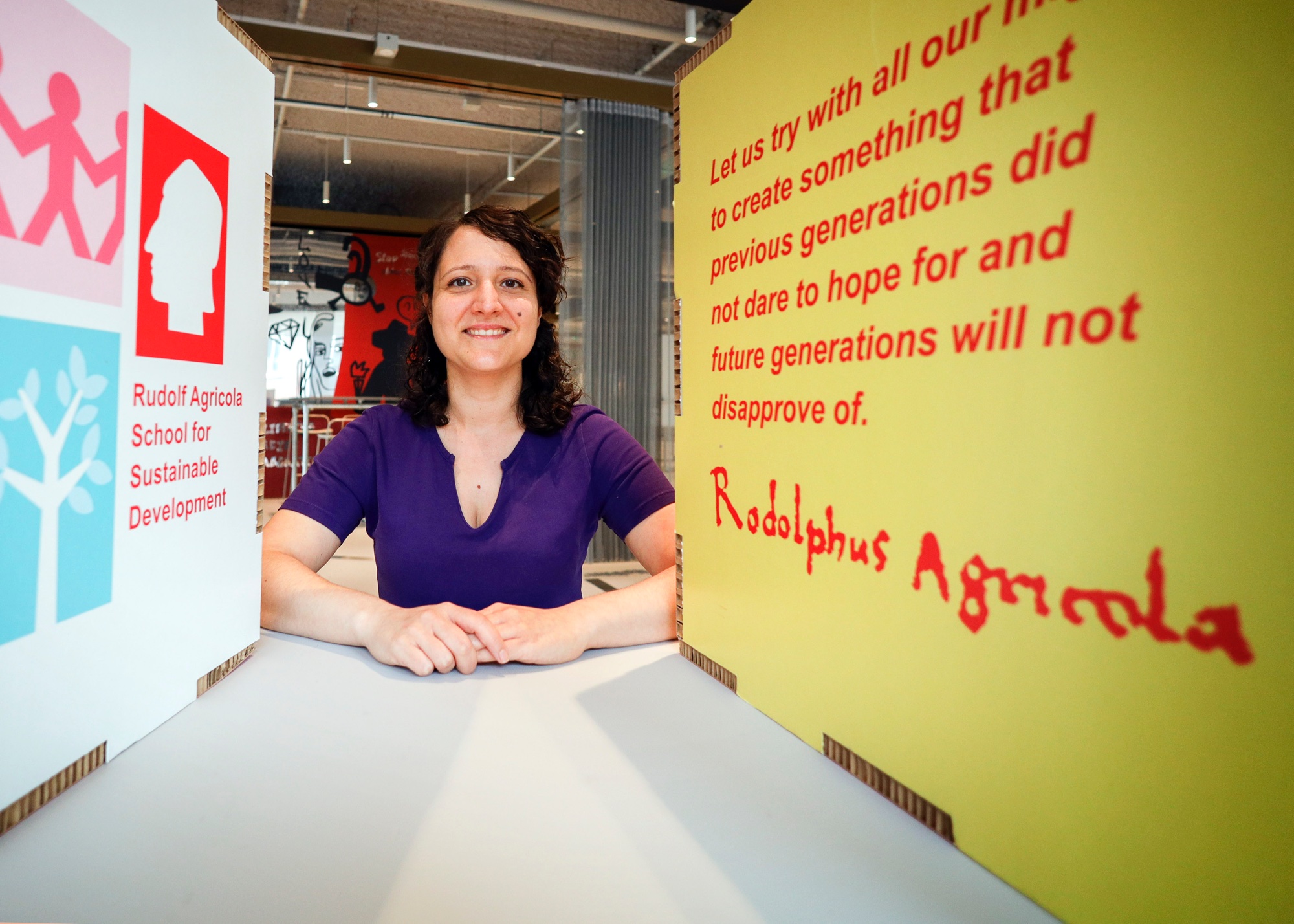How to deal with microplastics in our daily life

Microplastics are everywhere. These tiny pieces of plastic enter our bodies through the air that we breathe, the water we drink, and the food we eat. In her research, Irene Maltagliati, a PhD candidate in Health and Environmental communication and Scientific Coordinator at the Rudolf Agricola School, focuses on how we can be more aware of microplastics and change our behaviour.
Text: Jelle Posthuma / Photos: Henk Veenstra
‘I'm pretty sure microplastics are leaking from your disposable cup,’ Maltagliati says shortly after we have found a table in the local cafeteria. Indeed, the UG PhD candidate should know. Together with fellow researchers Josefine Geiger, Barbro Melgert, Marieke Wieringa, and João Graça, Maltagliati looks at behaviours involving microplastics. These tiny, solid plastic particles are emitted during the abrasion or degradation of plastic products and synthetic fabrics, and in most cases, are invisible to the naked eye. ‘We tend to associate microplastics with marine litter, but it is so much more than that.’
Thirty ways to be exposed
Maltagliati and her colleagues identified more than 30 behaviours that emit or expose us to microplastics. These include the drying of synthetic clothes, heating our meals that are kept in plastic containers in the microwave, and participating in traffic—abrasive car tyres are a major source of microplastics. ‘It is virtually impossible to avoid plastic in our daily life. Nevertheless, we can take action to try to prevent microplastics from ending up in the air, in our drinks, or in our food.’
Maltagliati’s research focuses on how citizens deal with microplastics. The project is part of the Microplastics and Human Health Consortium (MOMENTUM), funded by ZonMw. The aim of ‘Microplastics and Citizens’ is to raise public awareness about microplastics and their origins, to understand people’s concerns and empower them to change their daily behaviours.
Scary and overwhelming
The tiny pieces of plastic are found in various places in the human body, such as in your heart or lungs. Microplastics have even been found in placentas. This makes microplastics ‘quite a scary topic’, the PhD candidate points out. ‘We were shocked ourselves when we heard the long list of examples. That is why the project focuses on how we could best share knowledge about microplastics with citizens, without scaring or overwhelming them.’
‘When people are anxious or overwhelmed, or feel they can’t do anything about it, they are unlikely to take action. Fear leads to apathy, or dismissal of information. We sometimes notice this behaviour in response to climate change, for example. This is why communication is very important. We have to communicate about it as a problem, but at the same time provide concrete actions and offer a positive perspective.’

Changing behaviour
To better map citizens' awareness and habits, Maltagliati and her colleagues conduct interviews, set up focus groups, and conduct surveys with experts and the public, so that the researchers can identify how to motivate and help citizens to change their behaviour. Not all identified actions are equally impactful and easily changed. ‘That is why we focus on the most impactful behaviours.’
In this case, insights from the behavioural sciences are also very important, the PhD candidate continues. ‘Which behaviours we do the most and which are the easiest to change. Indoors, for example, it is feasible to ventilate and vacuum properly to prevent microplastics in the air. We can also easily replace some plastic products, such as the plastic cutting board or the plastic container we use for the microwave. However, sometimes things are beyond our direct control, such as the synthetic carpets in our offices or the traffic in the area we live in. In many cases, structural solutions are also needed.’
Important role nylon fibres
Much is still unknown about the health risks of microplastics, Maltagliati stresses. That is why the MOMENTUM consortium is also conducting research into the health effects. For instance, Barbro Melgert, Professor of Respiratory Immunology at the University of Groningen, is conducting research into the impact of microplastics on the lungs. She tested the effects of microplastic fibres on lung structures in the lab. Melgert found that nylon fibres in particular, caused problems in the growth and development of these structures. However, much more research is needed to determine the (harmful) effects of microplastics in the human body.
Sustainability trends
Maltagliati’s interest in microplastics grew while investigating sustainability trends for her PhD research. Together with her supervisors John Hoeks and João Graça, she looks into the question of: How do new sustainable behaviours emerge, spread, and become the 'normality'? For her PhD, she is looking at different trends, including plant-based eating, microplastics, and environmental education. All three trends are at a different stage. ‘The discourse around microplastics is really still in its early stages, while plant-based eating is now more widespread.’
The same applies to environmental education. For this part of her research, Maltagliati together with Josefine Geiger - expert in gamification and pro-environmental behaviour - is conducting research on secondary school teachers. At one of the schools, the teacher had their students take a look at the Arctic using interactive 360° videos to illustrate the effects of climate change. ‘The choice for these communication channels can help change students’ perceptions and behaviours, for example by talking about it with their parents and eating less meat.’

Working with the Plastic Soup Foundation
Maltagliati's research is often at the intersection of health and the environment. ‘These two areas come together in the theme of Planetary Health, which is all about how the health of our planet and ourselves are interconnected. Such a very complex topic requires interdisciplinary collaborations.’ Interdisciplinarity also plays a major role in the microplastic research. The ZonMw project involves 14 different experts from various disciplines, from academic researchers to societal organizations, including the Plastic Soup Foundation and the Municipality of Groningen, with Maltagliati making the connection.
Bringing scientists together
This role is not unfamiliar to her. Maltagliati is used to it from her position as scientific coordinator at the Rudolf Agricola School for Sustainable Development. As a coordinator, together with Wanli Zheng, she connects researchers from different fields. She also liaises with societal organizations. ‘Lately, my emphasis has been on education. How can we best apply interdisciplinarity and challenge-based methods in our education? There is so much knowledge within the university, but the connection is not always there. In addition, we hear from students that they are keen to learn about sustainability, but in an engaging and challenging way. We want to create a platform for that.’
The Rudolf Agricola School helps lecturers, students and other staff to connect with each other and with society. ‘Researchers and students increasingly feel the need to connect with the 'real world' through their work. By bringing together academic knowledge and knowledge from society, we can combine these forces. I believe the most interesting things happen at the intersection of disciplines.’
More information
| Last modified: | 20 June 2024 09.52 a.m. |
More news
-
12 March 2025
Breaking news: local journalism is alive
Local journalism is alive, still plays an important role in our lives and definitely has a future. In fact, local journalism can play a more crucial role than ever in creating our sense of community. But for that to happen, journalists will have to...
-
11 March 2025
Student challenge: Starting Stories
The Challenge Starting Stories dares you to think about the beginning of recent novels for ten days.
-
11 March 2025
New: Sketch Engine, tool for language research
Sketch Engine is a tool for language research, which can also be used for text analysis or text mining.
